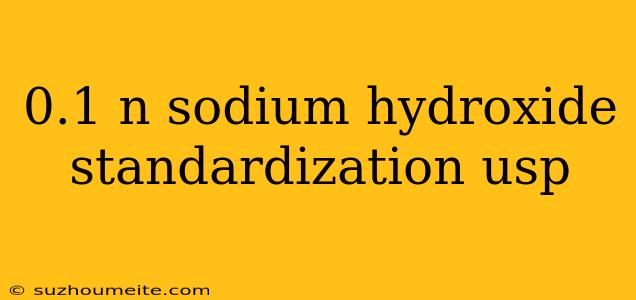Sodium Hydroxide 0.1 N Standardization (USP)
Introduction
Sodium hydroxide (NaOH) is a strong base widely used in various industries, including pharmaceuticals, chemical processing, and laboratory settings. In pharmaceutical analysis, sodium hydroxide 0.1 N is commonly used as a titrant for determining the acidity or alkalinity of substances. To ensure the accuracy and reliability of analytical results, it is essential to standardize the sodium hydroxide solution. This article outlines the standardization procedure for sodium hydroxide 0.1 N according to the United States Pharmacopeia (USP).
Principle
The standardization of sodium hydroxide 0.1 N involves the reaction between sodium hydroxide and potassium hydrogen phthalate (KHP). KHP is a primary standard substance, which means its exact concentration is known and can be used to determine the concentration of the sodium hydroxide solution. The reaction is as follows:
NaOH + KHC8H4O4 → NaKC8H4O4 + H2O
Materials
- Sodium hydroxide 0.1 N solution
- Potassium hydrogen phthalate (KHP)
- Distilled water
- pH indicator (e.g., phenolphthalein or methyl orange)
- Burette or pipette
Procedure
Preparation of KHP Solution
- Weigh accurately: Weigh 2-3 grams of potassium hydrogen phthalate (KHP) into a 100-mL beaker.
- Dissolve in water: Add approximately 50 mL of distilled water to the beaker and stir until the KHP is completely dissolved.
- Transfer to a volumetric flask: Transfer the KHP solution to a 100-mL volumetric flask and dilute to the mark with distilled water.
Standardization of Sodium Hydroxide 0.1 N
- Pipette KHP solution: Pipette 20-25 mL of the KHP solution into a conical flask.
- Add pH indicator: Add 2-3 drops of pH indicator (e.g., phenolphthalein or methyl orange) to the conical flask.
- Titrate with NaOH 0.1 N: Titrate the KHP solution with the sodium hydroxide 0.1 N solution until the endpoint is reached, as indicated by a color change of the pH indicator.
- Record the volume: Record the volume of sodium hydroxide 0.1 N solution required to reach the endpoint.
- Calculate the normality: Calculate the normality of the sodium hydroxide 0.1 N solution using the following formula:
Normality (N) = (Weight of KHP (g) x 1000) / (Volume of NaOH (mL) x Equivalent weight of KHP)
where the equivalent weight of KHP is 204.22 g/mol.
- Repeat the titration: Repeat the titration at least three times to ensure accuracy and reliability.
Calculation and Expression of Results
The normality of the sodium hydroxide 0.1 N solution is calculated and expressed as the average of the three replicate titrations. The results are reported as the normality of the sodium hydroxide 0.1 N solution, e.g., 0.102 N, 0.098 N, or 0.100 N.
Conclusion
In conclusion, the standardization of sodium hydroxide 0.1 N according to the USP involves the reaction between sodium hydroxide and potassium hydrogen phthalate. The procedure outlined in this article provides a precise and reliable method for determining the normality of sodium hydroxide 0.1 N solution, which is essential for ensuring the accuracy and reliability of analytical results in pharmaceutical analysis.
